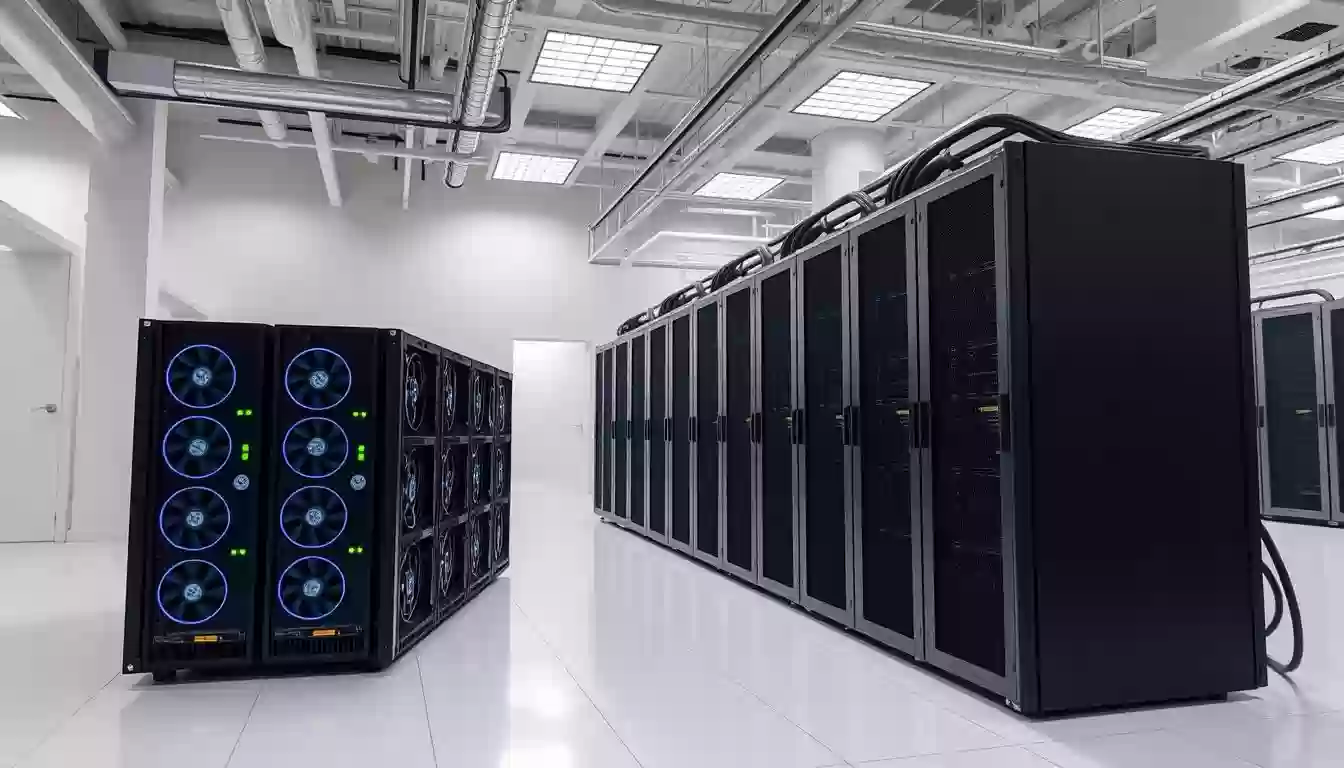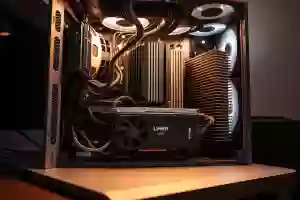Cloud Mining vs Hardware Mining: What's Best for You?
 02 Mar 25
02 Mar 25
Imagine the modern-day equivalent of the Gold Rush, but instead of pickaxes and pans, miners wield powerful computers and internet connections. Cryptocurrency mining has become the digital frontier, attracting enthusiasts worldwide. Just as the Gold Rush had its tools and strategies, today's miners face a crucial decision: cloud mining or hardware mining.
Hardware mining requires significant investment in mining rigs and energy, making it a costly venture. In contrast, cloud mining offers a more accessible entry point, allowing users to rent computing power from providers. This service eliminates the need for physical equipment, making it a popular choice for those new to mining.
Historically, mining has evolved from physical labor to digital processes. Today, miners must consider factors like cost, energy consumption, and technical challenges. This article will guide you through these aspects, helping you decide which method aligns best with your goals and resources.
Whether you're a tech-savvy individual or just exploring the world of crypto, understanding the differences between cloud and hardware mining is essential. Let's break down the key considerations, from ROI to operational costs, to help you make an informed decision.
Understanding Cryptocurrency Mining: A Modern-Day Gold Rush
Cryptocurrency mining is the backbone of blockchain technology, enabling the secure verification and recording of transactions without a central authority. Just as prospectors once panned for gold, today's miners solve complex mathematical puzzles to validate transactions and create new coins. This process not only secures the network but also rewards miners with cryptocurrency, making it a vital part of the digital economy.
What is Cryptocurrency Mining?
At its core, cryptocurrency mining involves solving intricate mathematical problems to validate transactions and add them to a blockchain. Miners compete to solve these problems first, using powerful computers that consume significant energy. The first miner to crack the code gets to add a new block of transactions to the blockchain and is rewarded with newly minted cryptocurrency. This process ensures the integrity and security of the blockchain, making it resistant to tampering or fraud.
From the Gold Rush to Digital Gold
Just as the Gold Rush of the 19th century drew thousands to the American West, the rise of cryptocurrency has sparked a modern-day rush for digital gold. Instead of pickaxes and pans, today's miners wield advanced computers and sophisticated software. The parallels are striking: both pursuits require determination, investment, and a bit of luck. While traditional mining focused on extracting precious metals from the earth, cryptocurrency mining extracts value from complex algorithms and blockchain verification processes.
| Aspect | Cloud Mining | Hardware Mining |
|---|---|---|
| Cost | No upfront hardware costs; subscription-based | High initial investment in mining rigs |
| Maintenance | Provider handles maintenance and updates | Requires regular upkeep and technical know-how |
| Energy Consumption | Energy costs are part of the service fee | High electricity bills for powering rigs |
| Accessibility | Open to anyone with an internet connection | Requires physical setup and technical expertise |
As the cryptocurrency landscape continues to evolve, miners face new challenges and opportunities. Whether you're drawn to the simplicity of cloud mining or the control of hardware mining, understanding the fundamentals is key to success in this digital frontier.
A Comprehensive Guide to cloud mining vs hardware mining
Understanding the differences between cloud and hardware mining is crucial for anyone looking to venture into cryptocurrency mining. Each method has its unique benefits and challenges, catering to different types of miners.
Defining Cloud Mining
Cloud mining allows users to lease computing power from remote data centers. This method eliminates the need for physical equipment, making it accessible to those without the resources for expensive hardware. Providers handle maintenance and energy costs, offering a hassle-free experience. It's ideal for newcomers or those preferring a hands-off approach.
Defining Hardware Mining
Hardware mining involves owning and operating mining rigs, typically using ASICs or GPUs. This traditional method offers full control over the mining process but requires significant investment in equipment and electricity. It's suited for experienced miners who can manage the setup and ongoing costs.
| Aspect | Cloud Mining | Hardware Mining |
|---|---|---|
| Cost | No upfront costs; subscription-based | High initial investment in rigs |
| Maintenance | Handled by providers | Requires regular upkeep |
| Energy | Costs included in fees | High electricity bills |
| Accessibility | Open to all with internet | Needs technical expertise |

Cloud mining offers flexibility and lower barriers to entry, while hardware mining provides control for those willing to invest time and resources. Understanding these differences helps miners choose the method that best fits their goals and capabilities.
Analyzing Costs, ROI, and Investment Considerations
When it comes to cryptocurrency mining, understanding the financial aspects is crucial for making informed decisions. Both hardware and cloud mining come with distinct cost structures and potential returns, shaping the profitability of your mining operation.
Evaluating Hardware Mining Costs and Profitability
Hardware mining requires a significant upfront investment in mining rigs, with high-end ASICs like the Antminer S19 XP costing around $10,000. Additionally, electricity bills can range from $100 to $500 per month, depending on your location and energy rates. Maintenance and setup costs add to the expense, but hardware mining can offer a quicker ROI, typically within 10-15 months, according to ROI calculators like NiceHash.
Understanding Cloud Mining Expenses and Subscriptions
Cloud mining operates on a subscription model, eliminating the need for physical equipment. Providers like Genesis Mining offer contracts starting at $500 for a 24-month term. While there are no upfront hardware costs, the ROI timeline is longer, often exceeding 20 months. Hidden fees and contract terms can impact profitability, so it's essential to review the terms carefully.
| Aspect | Hardware Mining | Cloud Mining |
|---|---|---|
| Upfront Costs | $10,000+ for ASICs | $500+ for contracts |
| Monthly Costs | $100-$500 in electricity | Subscription fees included |
| ROI Timeline | 10-15 months | 20+ months |
Hardware mining offers quicker returns but requires significant investment and technical expertise. Cloud mining provides a lower barrier to entry but with longer ROI timelines. Evaluating these factors will help you choose the mining method that aligns with your financial goals and risk tolerance.
Risk, Maintenance, and Technical Considerations in Mining Operations
As miners delve into the world of cryptocurrency, they must navigate a landscape filled with risks and ongoing maintenance demands. Whether choosing cloud or hardware mining, understanding these challenges is crucial for a successful mining operation.
Security and Scam Risks in Cloud Mining
Cloud mining presents unique security risks due to the lack of regulation in the industry. Many platforms have been known to operate as scams, making it essential for users to thoroughly research providers before committing. Hidden fees and unreliable services can also eat into potential profits. To mitigate these risks, it's advisable to join reliable mining pools and carefully review contract terms.
Managing Maintenance and Energy Costs in Hardware Mining
Hardware mining requires hands-on management of equipment and energy consumption. Miners must deal with high electricity bills, equipment wear and tear, and the heat generated by rigs. While this method offers more control, it demands significant time and resources to maintain optimal operations. Regular upkeep and technical expertise are essential to ensure profitability and longevity of the mining setup.
| Aspect | Cloud Mining | Hardware Mining |
|---|---|---|
| Security Risks | Scams, hidden fees, and unreliable providers | Equipment failure, energy fluctuations |
| Maintenance | Handled by providers | Regular upkeep and technical expertise required |
| Energy Costs | Included in service fees | High electricity bills |

While cloud mining offers a streamlined experience, hardware mining provides full control. By understanding these risks and maintenance demands, miners can make informed decisions that align with their resources and goals.
Conclusion
In the evolving world of cryptocurrency, the choice between cloud mining and hardware mining hinges on your personal goals, resources, and risk tolerance. Cloud mining offers a hassle-free entry with lower upfront costs, making it ideal for those seeking convenience and minimal investment. On the other hand, hardware mining provides greater control and potentially higher returns for those willing to invest in equipment and manage maintenance.
Financially, cloud mining typically requires a subscription-based model with longer ROI timelines, while hardware mining demands a significant initial investment but may yield quicker returns. Both methods carry unique risks, from scam risks in cloud mining to equipment failures in hardware mining. It's crucial to assess your technical expertise and financial capacity when deciding.
Ultimately, whether you opt for the simplicity of cloud mining or the control of hardware mining, understanding these factors will guide you toward a decision that aligns with your goals. With the right knowledge, you can confidently navigate the cryptocurrency landscape and unlock its potential.
FAQ
What is cloud mining?
Cloud mining is a process where you rent computing power from a provider to mine cryptocurrencies like Bitcoin. It eliminates the need for physical hardware, making it more accessible.
How does cloud mining differ from hardware mining?
Cloud mining uses remote servers, while hardware mining requires physical equipment like ASICs. Cloud mining offers lower upfront costs and ease of use, whereas hardware mining provides more control but involves higher initial investments and maintenance.
What are the costs involved in cloud mining?
Costs include subscription fees, electricity charges, and maintenance fees. These vary by provider, contract length, and the amount of computing power rented.
Is cloud mining profitable?
Profitability depends on factors like the mining difficulty, electricity costs, and the cryptocurrency's market price. It's essential to research and choose a reliable provider with transparent pricing.
What risks are associated with cloud mining?
Risks include potential scams, service interruptions, and market volatility. Always choose a reputable provider and be aware of the terms and conditions.
How long do cloud mining contracts typically last?
Contracts vary from a few months to several years, depending on the provider. Longer contracts may offer better returns but require a larger upfront investment.
Can I mine cryptocurrency without special hardware?
Yes, cloud mining allows you to mine without physical hardware. It's ideal for those who want to start without a significant investment in equipment.
How do I choose a reliable cloud mining service?
Research the provider's reputation, read reviews, and ensure they offer transparent pricing and contractual terms. Avoid services promising unusually high returns with little risk.
What is the energy consumption of cloud mining?
Energy consumption depends on the provider's infrastructure. While you don't manage the hardware, the provider's energy costs are typically included in your fees.
How do I get started with cloud mining?
Choose a provider, select a contract, create an account, and start mining. Ensure you understand the terms and fees before committing.





























